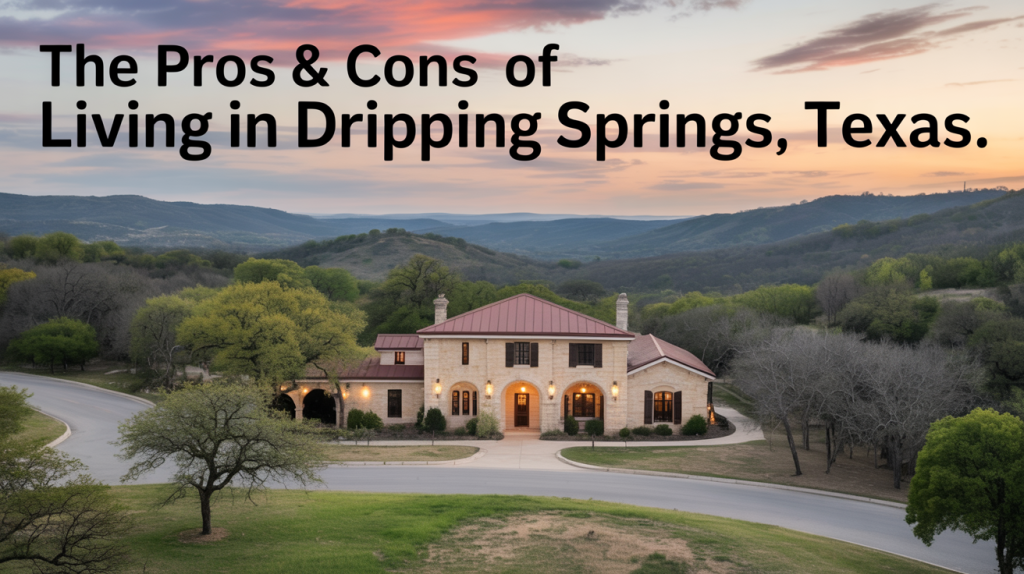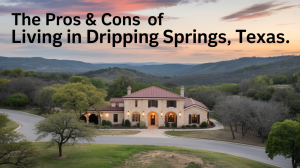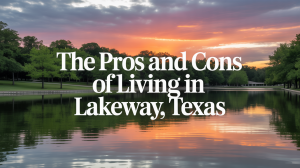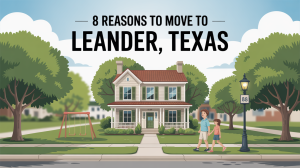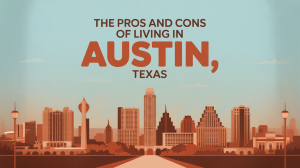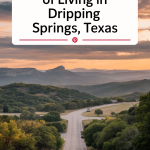Nestled in the heart of the Texas Hill Country, Dripping Springs is a city that has been rapidly growing in popularity. Known as the “Gateway to the Hill Country,” it offers a unique blend of small-town charm and easy access to the bustling city of Austin. But what is it really like to live in this booming Texas town? This article explores the pros and cons of living in Dripping Springs, providing a comprehensive overview for anyone considering a move.
Dripping Springs has experienced a massive population boom in recent years, with a 160.1% increase between 2010 and 2020. This growth has brought both opportunities and challenges, transforming the once-quiet rural town into a vibrant and sought-after community. From its stunning natural landscapes and friendly atmosphere to its rising cost of living and infrastructure growing pains, there are many factors to consider before calling Dripping Springs home. In this article, we’ll delve into the details, providing a balanced look at what you can expect from life in this unique Texas city.
The Pros: Living in Dripping Springs, Texas
Dripping Springs offers a lifestyle that many find irresistible. From its strong sense of community and excellent schools to its stunning natural beauty and proximity to Austin, there are many reasons why people are flocking to this Texas town.
A Hybrid of Rural and City Living
One of the biggest draws of Dripping Springs is its unique ability to offer a blend of rural and urban living. While the city is growing, it has managed to maintain its small-town charm. You’ll still find plenty of mom-and-pop shops and restaurants in the historic downtown area, and the surrounding landscape is dotted with large lots and sprawling ranches. This gives residents the opportunity to enjoy the peace and quiet of the countryside while still having access to modern amenities.
The historic downtown area of Dripping Springs offers a charming small-town feel. Image source: Sidecar Tasting Room.
A Strong Sense of Community
Texans are known for their friendly and welcoming nature, and Dripping Springs is no exception. The city has a strong sense of community, and it’s not uncommon for neighbors to become like family. Whether you need to borrow a cup of sugar or a helping hand, you can count on the people of Dripping Springs to be there for you. This tight-knit community is one of the things that residents cherish most about living here.
A Nature Lover’s Paradise
If you love the great outdoors, you’ll feel right at home in Dripping Springs. The city is surrounded by some of the most beautiful natural landscapes in Texas. From the iconic Hamilton Pool Preserve with its stunning grotto and waterfall to the expansive Pedernales Falls State Park, there are endless opportunities for hiking, swimming, fishing, and exploring. The area is also a designated “Bird City,” making it a haven for birdwatching enthusiasts.
Proximity to Austin and the Hill Country
Dripping Springs’ location is another major advantage. It’s just a 30-minute drive to downtown Austin (without traffic), giving residents easy access to the city’s vibrant music scene, world-class restaurants, and major employers. At the same time, it’s also the “Gateway to the Hill Country,” with charming towns like Wimberley and Johnson City just a short drive away. This central location allows residents to enjoy the best of both worlds.
Excellent Schools
For families with children, the quality of the schools is a top priority. The Dripping Springs Independent School District (DSISD) is highly-rated, consistently ranking as one of the best in the Austin area. The district is growing rapidly to keep up with the population boom, with a new high school and several new elementary and middle schools in the works. The schools’ commitment to academic excellence and innovative programs like “Leader in Me” make Dripping Springs a great place to raise a family.

The Cons: Living In Dripping Springs, Texas
While Dripping Springs has a lot to offer, its rapid growth has also brought about some significant challenges. From traffic congestion and a rising cost of living to concerns about water sustainability, there are several drawbacks to consider before making a move.
Transportation and Traffic
One of the most common complaints from residents is the traffic. The city’s infrastructure has struggled to keep up with the population boom, and the small, two-lane roads can become easily congested. The commute to Austin, in particular, can be a major headache, with travel times ranging from 45 minutes to an hour and a half during rush hour. While the new Oakhill Parkway flyover is expected to alleviate some of the congestion on Highway 290, traffic will likely remain a challenge for the foreseeable future.
High Cost of Living
The secret is out about Dripping Springs, and the cost of living has risen accordingly. Housing prices, in particular, have skyrocketed in recent years. While the market has cooled slightly from its peak, the median home price is still significantly higher than the national average. This has made it difficult for many people, especially service workers, to afford to live in the community. The high cost of housing is a major concern for the city, and they are exploring ways to bring more affordable options to the area.
Water Sustainability
As more and more people move to Dripping Springs, there is growing concern about the sustainability of the water supply. Many homes in the area rely on well water, and the increased demand is putting a strain on the local aquifers. Some residents have had to drill deeper wells to access water, and there are ongoing debates about how to best manage this precious resource. The city is working with conservationists and planners to address these concerns, but water will likely remain a key issue for the community in the years to come.
Limited Amenities
While Dripping Springs has a growing number of shops and restaurants, it still lacks the variety of amenities that you would find in a larger city. Residents may need to travel to Austin or other nearby towns for certain shopping, dining, or entertainment options. Additionally, public transportation is limited, and ride-sharing services like Uber are not readily available.
Popular Neighborhoods and Communities In Dripping Springs
Dripping Springs offers a diverse range of neighborhoods, from master-planned communities with resort-style amenities to rural subdivisions with expansive lots. Here’s a guide to some of the most popular areas:
Master-Planned Communities
Belterra: The Premier Community
Spanning 1,600 acres, Belterra is one of the largest and most sought-after master-planned communities in Dripping Springs. Located just 18 miles from downtown Austin, Belterra was awarded the 2015 Master-Planned Community of the Year by the Austin Home Builder’s Association.
– Home Prices: $400,000 to $1.2 million, featuring 1,800–4,000 sq ft homes
– Key Amenities: Resort-style pool complex, recreation center with gym and basketball court, 17 miles of hiking and biking trails through 12 parks, and Belterra Village shopping center
– Schools: Rooster Springs Elementary on-site, plus other top DSISD schools
– Best For: Active families who want extensive amenities and easy access to both Austin and Dripping Springs
Caliterra: Luxury Meets Nature
This 600-acre master-planned community sits along Onion Creek and emphasizes sustainable living with Hill Country charm. Located just 5 miles from downtown Dripping Springs, Caliterra offers over 250 acres of green space.
– Home Prices: $600,000 to $1.5 million, with generous lot sizes from 0.25 to 1 acre
– Key Amenities: The Hub community center with coffee shop, resort-style pool and splash pad, 3 miles of trails along Barton Creek, dog park
– Schools: Zoned to highly-rated Dripping Springs ISD schools
– Best For: Families and professionals who enjoy luxury homes, outdoor activities, and community events
Headwaters: Wellness and Hill Country Serenity
Spanning 1,000 acres along Highway 290, Headwaters emphasizes wellness and connectivity with nature. The community features panoramic Hill Country views and focuses on healthy living.
– Home Prices: $500,000 to $1.5 million, with 2,000–5,000 sq ft properties on up to 1-acre lots
– Key Amenities: Planned 2-acre Crystal Lagoon, fitness center, 7 miles of trails, 150-acre preserve, future on-site elementary school
– Schools: Part of Dripping Springs ISD, with plans for an on-site school
– Best For: Those seeking modern designs, wellness amenities, and extensive customization options
Highpointe: Gated Luxury
This 740-acre gated community offers approximately 1,000 upscale homes with enhanced security and privacy. Located near Belterra, it provides a more intimate setting while maintaining easy access to Austin.
– Home Prices: Higher-end luxury homes with premium finishes
– Key Amenities: Two-story gym, three pools including children’s water park, sports fields, tennis courts, putting green
– Schools: Access to top-rated DSISD schools
– Best For: Luxury buyers seeking security, privacy, and upscale amenities
Rural and Established Neighborhoods
Arrowhead Ranch: Quiet and Spacious
Located on the western edge of Dripping Springs, this community offers larger lots and more privacy than the master-planned communities.
– Home Prices: $550,000 to $1 million, with 2,500–4,000 sq ft on 1–3-acre lots
– Key Amenities: Community pool, playgrounds, nature trails, river access
– Best For: Those wanting tranquility close to downtown Dripping Springs
Saratoga Hills: Rural Serenity
Ideal for buyers craving space, this neighborhood features 1–5-acre lots with minimal community amenities, focusing on privacy and open land.
– Home Prices: $450,000 to $900,000, typically 2,000–3,500 sq ft homes
– Best For: Those seeking elbow room, gardening space, or workshop areas in a rural atmosphere
Choosing the Right Neighborhood In Dripping Springs
When selecting a neighborhood in Dripping Springs, consider these factors:
– Lifestyle Preferences: Master-planned communities offer structured amenities and social events, while rural neighborhoods provide privacy and space
– Commute Needs: Communities closer to Highway 290 offer easier access to Austin
– Budget: Master-planned communities typically have higher HOA fees but include extensive amenities
– Family Needs: Consider proximity to schools, playgrounds, and family-friendly amenities
The Verdict: Is Dripping Springs Right for You?
Dripping Springs is a city of contrasts. It’s a place where you can enjoy the tranquility of the Hill Country and the excitement of Austin. It’s a community that values its small-town roots while embracing rapid growth. And it’s a city that offers a high quality of life, but at a price.
Ultimately, whether or not Dripping Springs is the right place for you will depend on your individual priorities and lifestyle. If you’re looking for a friendly, tight-knit community with excellent schools and abundant natural beauty, and you don’t mind a bit of a commute, then Dripping Springs could be your perfect home. However, if you’re on a tight budget or you crave the convenience and amenities of a big city, you may want to look elsewhere.
As Dripping Springs continues to grow and evolve, it will be interesting to see how the community addresses the challenges of its own success. But one thing is for sure: this “Gateway to the Hill Country” will continue to be a desirable destination for those seeking a unique and vibrant Texas lifestyle.

